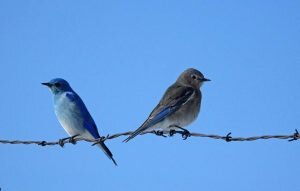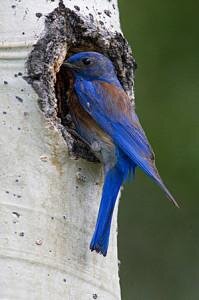April Nature Almanac: Bluebirds Make Our Hearts Sing
By Ruth Carol Cushman and Stephen Jones
April 2021
How did bluebirds acquire their dazzling color? Once upon a time, according to folklore, all the birds and animals were painted but one. The forgotten bird flew up into the sky to protest its drab coat, and bits of sky stuck to its feathers. Today, we still thrill to see that dazzling color whenever we see a bluebird.
Male (left) and female (right) Mountain Bluebird. Photo by Steve Jones
The mountain bluebird, the most common bluebird in Colorado, migrates to Texas and Mexico in winter though a few mavericks turn up every year on the Christmas Bird Counts. Large flocks, sometimes numbering more than 100 individuals, start to return to Boulder County in February. This year the first one was reported on the COBIRDS email list on February 26 from the foothills above Lyons. Often perching on mullein stalks and yuccas, these insectivores forage for insects in order to fatten up before heading to higher elevations to nest in April and May. Vivid turquoise backs characterize the males, while the soft blue and gray plumage of females may be less conspicuous to predators.
We are lucky in Boulder County as both western and eastern bluebirds also occur. With rich blue backs, orange-red breasts, and white bellies, the two species appear similar, but the red extends all the way up the throat on eastern bluebirds. In some places in the foothills, western bluebirds have become more common than mountain bluebirds. Considered uncommon in Boulder County 35 years ago, western bluebirds are now our most abundant breeding bluebird.
Male Eastern Bluebird. Photo by Chris Petrizzo.
Surprisingly, the eastern bluebird, the least common bluebird in Boulder County, is the one we see most often in winter. Twelve were reported on the 2020 Christmas Bird Count, and it was the only bluebird species seen that day. This was an upswing in their numbers over past years. Ecologist Scott Severs speculates that the increase may have stemmed from milder than average temperatures and low snow cover in December and January. Also, as we become more suburbanized, there are more trees and food sources. Resourceful eastern bluebirds change their diet in winter from mostly bugs to mostly berries.
Although bluebird populations are stable now, they were in severe decline in the mid-twentieth century largely due to competition with starlings and house sparrows for nesting cavities. If we love bluebirds, we should also cherish the dead snags that provide natural nesting cavities.
These adaptable birds also take to nesting boxes, so during the decline, people throughout the country responded by building and monitoring nesting boxes specifically designed for bluebirds. To keep out larger birds, the entry hole should be no larger than 1.75 inches in diameter and should be about 6 inches above the floor of the box, a size that also accommodates tree swallows. These boxes were frequently placed in such a way as to form a bluebird box trail to help with monitoring.
Next June check out the bluebird trails adjacent to Meyers Homestead Trail, at the Betasso Nature Preserve, and along the lower section of Rollins Pass Road. Sadly, all 17 bluebird boxes at Heil Ranch were destroyed in the 2020 Lefthand Canyon fire that also burned trees and habitat. "Only the hardware (screws, nails, metal hole guard) remained in a pile at the base of the trees,” writes wildlife biologist Michelle Durant, who hopes to have the routes up again by 2022.
Bluebirds have a distinctive lilting flight pattern and often hover for several minutes at a time. Like tiny cerulean kestrels, they stare intently at the ground while hanging motionless in the air before darting down for a tasty bug. They also employ a technique called ground-sallying — flying down from a perch to catch an insect on the ground and then returning to the same perch.
For many of us, bluebirds are a beloved harbinger of spring, making our hearts soar and occasionally skip a beat—just like the bird’s rising and dipping flight.
[Editor’s Note: You can learn more about BCAS’s collaborative bluebird monitoring project here.]
Male Western Bluebird at nest cavity. Photo by Gerhard Assenmacher.
Additional April events
Pasqueflowers, spring beauties, chiming bells, mustards, milkvetches, and wild plums bloom in the foothills attracting early butterflies such as Julia orangetips, cabbage whites, and spring azures.
Burrowing owls, turkey vultures, and broad-tailed hummingbirds return from the south.
Bullsnakes awake from hibernation and mate. They eat mice and voles, but also climb trees to take baby birds.
Painted turtles emerge from their winter torpor in the mud and bask on logs at Sawhill and other local ponds.
Beaver, raccoon, and porcupine young are born, and baby prairie dogs appear above ground.
Ruth Carol Cushman and Stephen Jones are authors of Wild Boulder County and The North American Prairie.



